By: Andy Biggs
The Choice of Digital
This past June, my wife and I embarked on a 5-week trip throughout east Africa. We climbed Mount Kilimanjaro, went on numerous safaris in Kenya and Tanzania, and enjoyed the Swahili culture of Zanzibar Island. But which photographic equipment would I take on such a trip? 35mm? digital? 4×5 large format? I went through many rumblings on whether or not to do an African trip with all-digital camera equipment. In the past, I have been married to Nikon 35mm film equipment for trips like this one. I also shoot 4×5 b&w and color landscapes, so I had a difficult choice to make. Based on conversations with friends and online acquaintances, I was looking at shooting about 5-10 rolls of film per day while on safari and 2-5 rolls on other days‚ if I were to shoot film on this trip. After going back and forth regarding just the film costs with my Nikon film gear (anticipated cost of about $1,500 for Velvia, Provia 100F and processing), I finally decided to move into the digital SLR arena. My choice was based upon many aspects: ongoing costs of film development, ability to choose your ISO while in the field on a per-image basis, less bulk of digital storage options, instant feedback, and many other factors. But which system to choose?
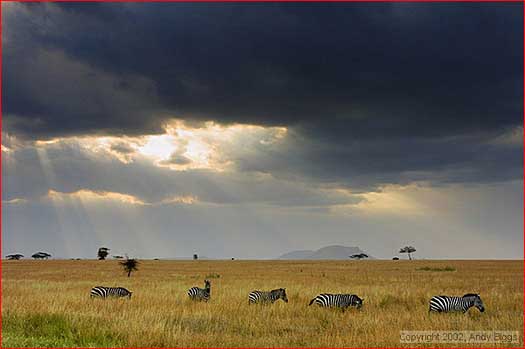
Zebra Sunset, Serengeti National Park, Tanzania, 2002
Photographed with a Canon EOS D30 and 28-70mm f/2.8L lens @ 40mm
Equipment Choices
Well, I finally decided on the Canon D60. Why? (1) The D60 offers a wonderful color palette, (2) the 6MP resolution is to my liking now that decent sized prints can be made from the photos, and (3) the CMOS imager does not collect nearly the amount of dust that a CCD does (Nikon D1x, Nikon D100 and Canon 1D bodies use the CCD imager). This is extremely important to me as a nature photographer. I cannot stress this enough! (I am quite giddy at the moment, as Kodak and Canon have both announced two digital SLR’s that are high in the pixel count, and both are based on CMOS technology. Hooray for nature photographers).
Well, since our Africa trip left on June 7, not many D60’s were out the door to their new owners. So, I decided to go ahead and purchase a used D30 on eBay, just in case. This turned out to be a good thing, as no D60 graced my doorstep before we departed. I was disappointed, but the two cameras are very similar in everything except resolution and minor enhancements on the D60. So, the D30 is what I took. I took a Canon Elan 7e as a backup body, and I also took an Olympus 3030 for quick shots, where a large camera would attract too much attention.
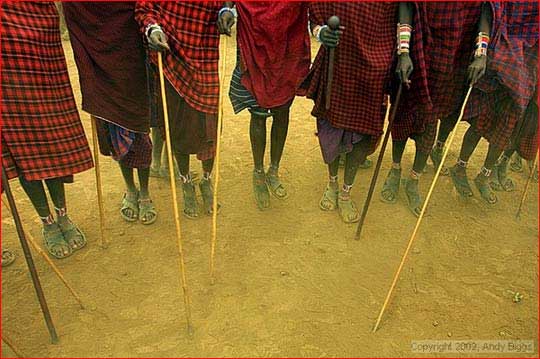
Maasai Warriors, Amboseli National Park, Kenya, 2002
Photographed with a Canon EOS D30 and 16-35mm f/2.8L lens @ 16mm
In east Africa, like many other places in Africa, your camera equipment represents mega bucks to the locals. Since Kenyan and Tanzanian people earn about $30 to $50 per month on average, you and your camera equipment are noticed very quickly. Therefore, you will need to be wise about when and where to bring out your camera gear in urban settings. As a general rule I decided the risk just wasn’t worth it, specifically in large cities like Nairobi (commonly referred to as Nairobbery) and Dar Es Salaam.
I did not take a photo bag with me, per se. I took a day pack both for the Kilimanjaro climb, and for carrying my camera outfit in for the rest of the journey. This turned out to be a very good decision. Imagine packing for a trip from the equator to the North Pole in one trip. Well, that is what we did. Many things that I packed had to act as dual-purpose items. For example: when on Kilimanjaro, you never know what the weather will be like in twenty minutes. Therefore, we packed rain covers for our day packs from REI. Great planning, but we never needed them. However, while on safari, my rain cover worked very well as a dust cover for my D30 and an attached lens (I took the 16-35mm f2.8L, 28-70 f2.8L and 100-400 f4.5 – f5.6L lenses). My other two lenses were in neoprene Zing pouches in my day pack. When driving between locations, I would wrap my D30 and attached lens in my rain cover in my lap. This worked perfectly to keep the dust off. I also left my Gitzo 1228 at home. Good choice and a bad choice. Since my mantra was to pack everything into one large bag, I decided the extra weight and bulk could not be afforded. However, I could have used it while photographing from our 4×4 vehicle. I would have used it as a monopod for wildlife, and as a tripod for landscapes.
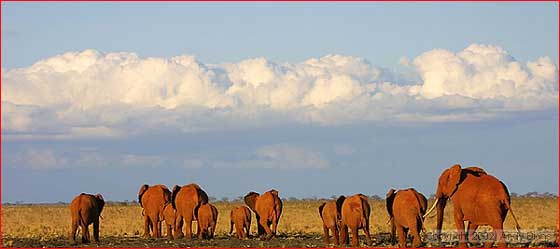
Red Elephants, Tsavo East National Park, Kenya, 2002
Photographed with a Canon EOS D30 and 28-70mm f/2.8L lens @ 70mm
Dust Dust Dust
Depending on where you go on your safari, and at what time of year, you might encounter heavy rains and a soaked landscape‚ or a huge dust bowl. Before you plan your trip on an African safari know where you would like to photograph, when you might be able to travel, and plan accordingly. We chose to travel in June and early July, since the short rains (February through May) render the landscape green and lush, without the daily rains. If you are interested in photographing the wildebeast migration on the Maasai Plain, whether the Serengeti or Maasai Mara, you will need to be there December through February.
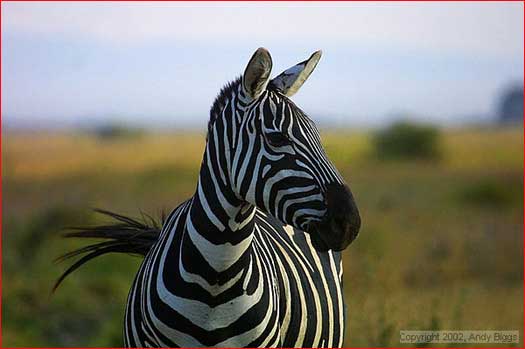
Zebra, Serengeti National Park, Tanzania, 2002
Photographed with a Canon EOS D30 and 100-400mm f/4.5 – f5.6L lens @ 400mm
The Need for Power
Digital SLR’s need some serious battery power. The D30/D60 cameras have wonderful battery life, so I decided to take three batteries. In hind sight, this would be the absolute minimum. While I was shooting with one battery in the D30, the other two batteries were always in the charger, plugged into the lighter socket in our 4×4. Keep in mind, most vehicles in East Africa have 12v sockets. However, older Japanese vehicles (Landcruisers) might use 24v lighter sockets. I brought along the Canon charger, and it worked well. However, on one of our safaris, we were in an older Landcruiser, and the lighter socket must have had a bad connection to the battery, as the charger only worked intermittently. This is something I took care of later each evening, by bribing another vehicle’s driver to let me charge off of his battery.
You will also need constant, non-battery based power to clean dust off your sensor each evening. I spent the first few nights feverishly finding those little devils of dirt, only to fall behind after a couple of days due to being very tired at the end of the day. With mindful management of covering your camera when not in use, and changing lenses in dust-free areas, I got to the point where I only needed to clean the sensor once a week. This is definitely more than I clean the sensor at home, but then again, I have never been to a more dusty environment for photography before. Ever.
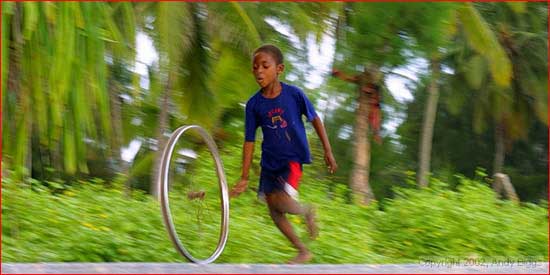
Boy with Wheel, Nungwi, Zanzibar, 2002
Photographed with a Canon EOS D30 and 28-70mm f/2.8L lens @ 70mm
Digital Storage
This actually ties into the need for remote power. After doing extensive research on all portable digital backup devices, I decided on the affordable Image Bank. The main reason was the diversity of powering the unit: 110v/220v DC, 12v/24v automobile and six AA batteries. The AA batteries turned out to be a great decision, as you can purchase these batteries in any country in the world. I seriously doubt that you would be able to find a replacement proprietary battery for other competing units, in case of failure. Also, since we decided to take camping safaris, the ability to recharge batteries was slim to none. With a 40GB hard drive inside, I filled up about 12GB of data by the end of the trip. Just think, if I were shooting with a D60, that would have been 24GB, or with the upcoming 1Ds, definitely more than the capacity of this 40GB drive. Definitely plan ahead, and know what your data storage needs will be.

Zebras at Watering Hole, Serengeti National Park, Tanzania, 2002
Photographed with a Canon EOS D30 and 100-400mm f/4.5 – f5.6L lens @ 300mm
Conclusion
With today’s digital SLR technology, and the growing selection of equipment to support these digital SLR’s, I can only recommend a digital safari over a film-based safari. And hooray to Canon for bringing out more models based upon CMOS technology, and Kodak for their latest announcement of their own camera, based upon CMOS designs.
Photographs and Text © 2002 Andy Biggs
Andy Biggs is an Austin, Texas-based software consultant and avid landscape and adventure photographer. More of his work can be seen atwww.andybiggs.com.
You May Also Enjoy...
Inca_Trail_KM_104
Km 104©Miles HeckerCLICK ABOVE IMAGE TO SEE GOOGLE MAP LOCATION SEASONS The one day Inca Trail hike begins at KM104 on the train right of
